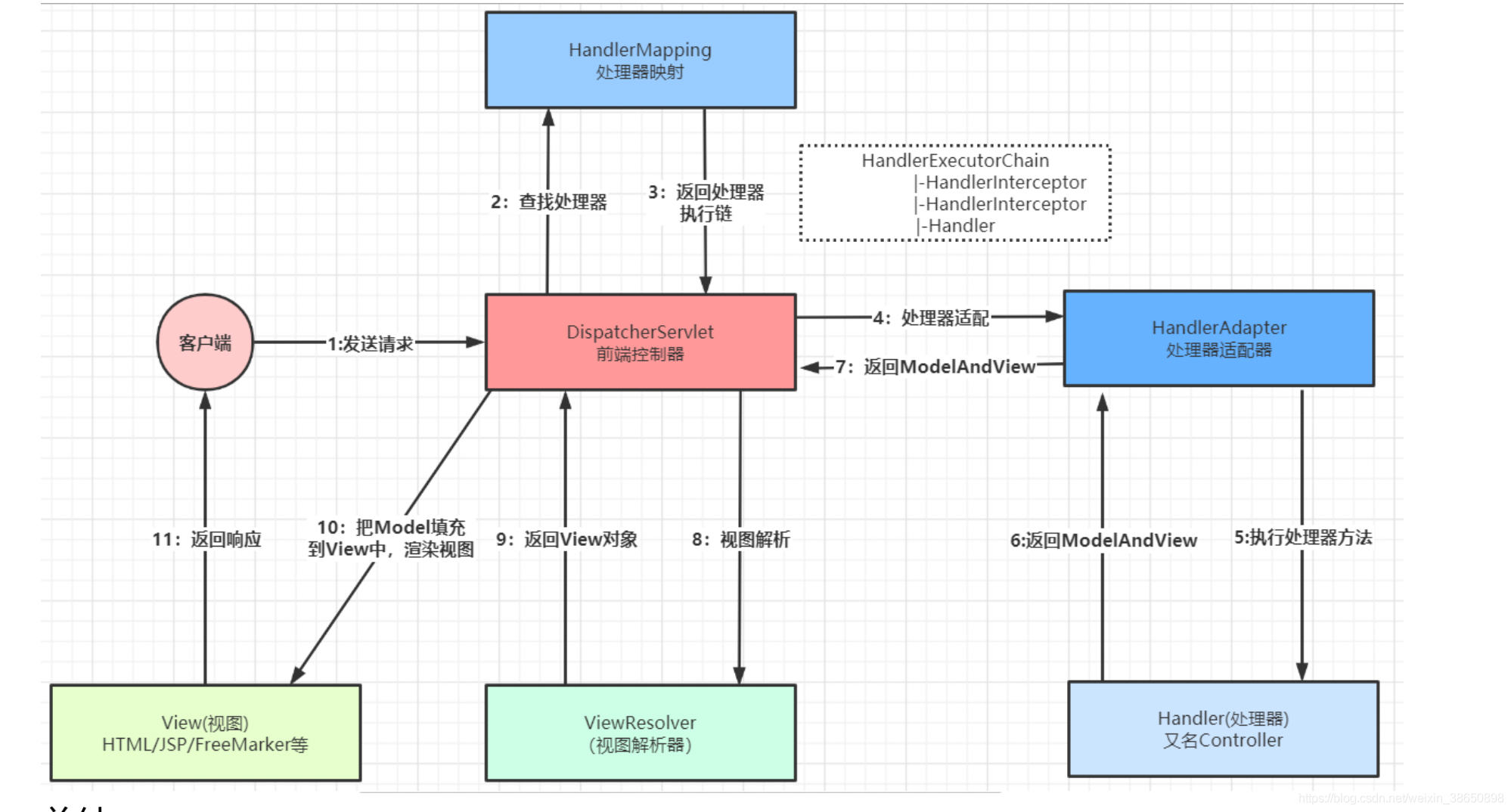
上图是Spring MVC的执行流程图,当一个请求经过 Tomcat 来到Spring MVC 的时候,它会被一个 Servlet 所处理,而Spring MVC的核心,就是这样的一个Servlet,即DispatcherServlet 。 注意,Spring MVC主要是处理web http请求,所以框架内部对http协议参数的处理贯穿整个框架,比如控制缓存头参数,上次修改时间参数等等http参数。另外,现在基本都是前后端分离的开发模式,所以View 基本就不会使用到了。
Spring MVC 容器启动
它会完成Spring MVC的初始化操作。
public class DispatcherServlet extends FrameworkServlet {
@Override
protected void onRefresh(ApplicationContext context) {
initStrategies(context);
}
protected void initStrategies(ApplicationContext context) {
initMultipartResolver(context);
initLocaleResolver(context);
initThemeResolver(context);
initHandlerMappings(context);
initHandlerAdapters(context);
initHandlerExceptionResolvers(context);
initRequestToViewNameTranslator(context);
initViewResolvers(context);
initFlashMapManager(context);
}
}而onRefresh 方法在什么地方调用呢?在初始化 Web 容器的时候,Spring MVC 里面有两种容器,一个是父容器Spring 容器,一个是Spring MVC 子容器。
public abstract class FrameworkServlet extends HttpServletBean implements ApplicationContextAware {
protected WebApplicationContext initWebApplicationContext() {
WebApplicationContext rootContext =
WebApplicationContextUtils.getWebApplicationContext(getServletContext());
WebApplicationContext wac = null;
if (this.webApplicationContext != null) {
// A context instance was injected at construction time -> use it
wac = this.webApplicationContext;
if (wac instanceof ConfigurableWebApplicationContext) {
ConfigurableWebApplicationContext cwac = (ConfigurableWebApplicationContext) wac;
if (!cwac.isActive()) {
// The context has not yet been refreshed -> provide services such as
// setting the parent context, setting the application context id, etc
if (cwac.getParent() == null) {
// The context instance was injected without an explicit parent -> set
// the root application context (if any; may be null) as the parent
cwac.setParent(rootContext);
}
configureAndRefreshWebApplicationContext(cwac);
}
}
}
if (wac == null) {
// No context instance was injected at construction time -> see if one
// has been registered in the servlet context. If one exists, it is assumed
// that the parent context (if any) has already been set and that the
// user has performed any initialization such as setting the context id
wac = findWebApplicationContext();
}
if (wac == null) {
// No context instance is defined for this servlet -> create a local one
wac = createWebApplicationContext(rootContext);
}
if (!this.refreshEventReceived) {
// Either the context is not a ConfigurableApplicationContext with refresh
// support or the context injected at construction time had already been
// refreshed -> trigger initial onRefresh manually here.
synchronized (this.onRefreshMonitor) {
onRefresh(wac);
}
}
if (this.publishContext) {
// Publish the context as a servlet context attribute.
String attrName = getServletContextAttributeName();
getServletContext().setAttribute(attrName, wac);
}
return wac;
}
}初始化基本环境
initStrategies 方法主要是注入一些默认实现类,比如 initHandlerMappings(context) 方法就是注入扫描出handlerMappings 的默认实现类。
private void initHandlerMappings(ApplicationContext context) {
this.handlerMappings = null;
if (this.detectAllHandlerMappings) {
// Find all HandlerMappings in the ApplicationContext, including ancestor contexts.
Map<String, HandlerMapping> matchingBeans =
BeanFactoryUtils.beansOfTypeIncludingAncestors(context, HandlerMapping.class, true, false);
if (!matchingBeans.isEmpty()) {
this.handlerMappings = new ArrayList<>(matchingBeans.values());
AnnotationAwareOrderComparator.sort(this.handlerMappings);
}
}
else {
try {
HandlerMapping hm = context.getBean(HANDLER_MAPPING_BEAN_NAME, HandlerMapping.class);
this.handlerMappings = Collections.singletonList(hm);
}
catch (NoSuchBeanDefinitionException ex) {
}
}
// Ensure we have at least one HandlerMapping, by registering
// a default HandlerMapping if no other mappings are found.
if (this.handlerMappings == null) {
this.handlerMappings = getDefaultStrategies(context, HandlerMapping.class);
...
}
}handlerMappings默认会从容器中获取HandlerMapping 类型的所有类。 getDefaultStrategies 方法是一个兜底的方法,一般不会进入到这个代码分支,它会从DispatcherServlet.properties 文件中注入各个类的默认实现类。
# Default implementation classes for DispatcherServlet's strategy interfaces.
# Used as fallback when no matching beans are found in the DispatcherServlet context.
# Not meant to be customized by application developers.
org.springframework.web.servlet.LocaleResolver=org.springframework.web.servlet.i18n.AcceptHeaderLocaleResolver
org.springframework.web.servlet.ThemeResolver=org.springframework.web.servlet.theme.FixedThemeResolver
org.springframework.web.servlet.HandlerMapping=org.springframework.web.servlet.handler.BeanNameUrlHandlerMapping,\
org.springframework.web.servlet.mvc.method.annotation.RequestMappingHandlerMapping
org.springframework.web.servlet.HandlerAdapter=org.springframework.web.servlet.mvc.HttpRequestHandlerAdapter,\
org.springframework.web.servlet.mvc.SimpleControllerHandlerAdapter,\
org.springframework.web.servlet.mvc.method.annotation.RequestMappingHandlerAdapter
org.springframework.web.servlet.HandlerExceptionResolver=org.springframework.web.servlet.mvc.method.annotation.ExceptionHandlerExceptionResolver,\
org.springframework.web.servlet.mvc.annotation.ResponseStatusExceptionResolver,\
org.springframework.web.servlet.mvc.support.DefaultHandlerExceptionResolver
org.springframework.web.servlet.RequestToViewNameTranslator=org.springframework.web.servlet.view.DefaultRequestToViewNameTranslator
org.springframework.web.servlet.ViewResolver=org.springframework.web.servlet.view.InternalResourceViewResolver
org.springframework.web.servlet.FlashMapManager=org.springframework.web.servlet.support.SessionFlashMapManager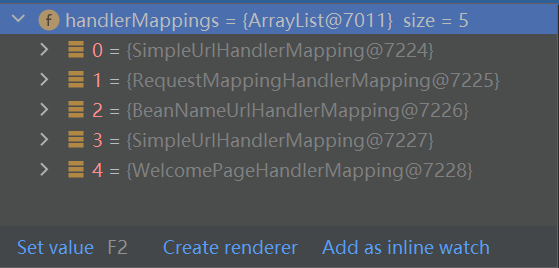
扫描RequestMapping
另外,很明显早启动时程序会扫描@Controller注释的类,把所有的@RequestMapping注释的方法全都转为HandlerMethod,并用一个Map保存起来,那么这一步是在什么时候做的呢?原来 RequestMappingHandlerMapping 在创建的时候会触发 afterPropertiesSet()方法,这是InitializingBean 接口的钩子方法,它就是在这里完成这个步骤的。
public abstract class AbstractHandlerMethodMapping<T> extends AbstractHandlerMapping implements InitializingBean {
protected void initHandlerMethods() {
for (String beanName : getCandidateBeanNames()) {
if (!beanName.startsWith(SCOPED_TARGET_NAME_PREFIX)) {
processCandidateBean(beanName);
}
}
handlerMethodsInitialized(getHandlerMethods());
}
protected void processCandidateBean(String beanName) {
Class<?> beanType = null;
try {
beanType = obtainApplicationContext().getType(beanName);
}
catch (Throwable ex) {
...
}
if (beanType != null && isHandler(beanType)) {
detectHandlerMethods(beanName);
}
}
protected boolean isHandler(Class<?> beanType) {
return (AnnotatedElementUtils.hasAnnotation(beanType, Controller.class) ||
AnnotatedElementUtils.hasAnnotation(beanType, RequestMapping.class));
}
protected void detectHandlerMethods(Object handler) {
Class<?> handlerType = (handler instanceof String ?
obtainApplicationContext().getType((String) handler) : handler.getClass());
if (handlerType != null) {
Class<?> userType = ClassUtils.getUserClass(handlerType);
Map<Method, T> methods = MethodIntrospector.selectMethods(userType,
(MethodIntrospector.MetadataLookup<T>) method -> {
try {
return getMappingForMethod(method, userType);
}
catch (Throwable ex) {
throw new IllegalStateException("Invalid mapping on handler class [" +
userType.getName() + "]: " + method, ex);
}
});
...
methods.forEach((method, mapping) -> {
Method invocableMethod = AopUtils.selectInvocableMethod(method, userType);
registerHandlerMethod(handler, invocableMethod, mapping);
});
}
}
}registerHandlerMethod(handler, invocableMethod, mapping) 把一个Method注册到一个Map<RequestMappingInfo,HandlerMethod>类型的变量里去,等后面一个请求来时就来到这里寻找匹配的HandlerMethod。
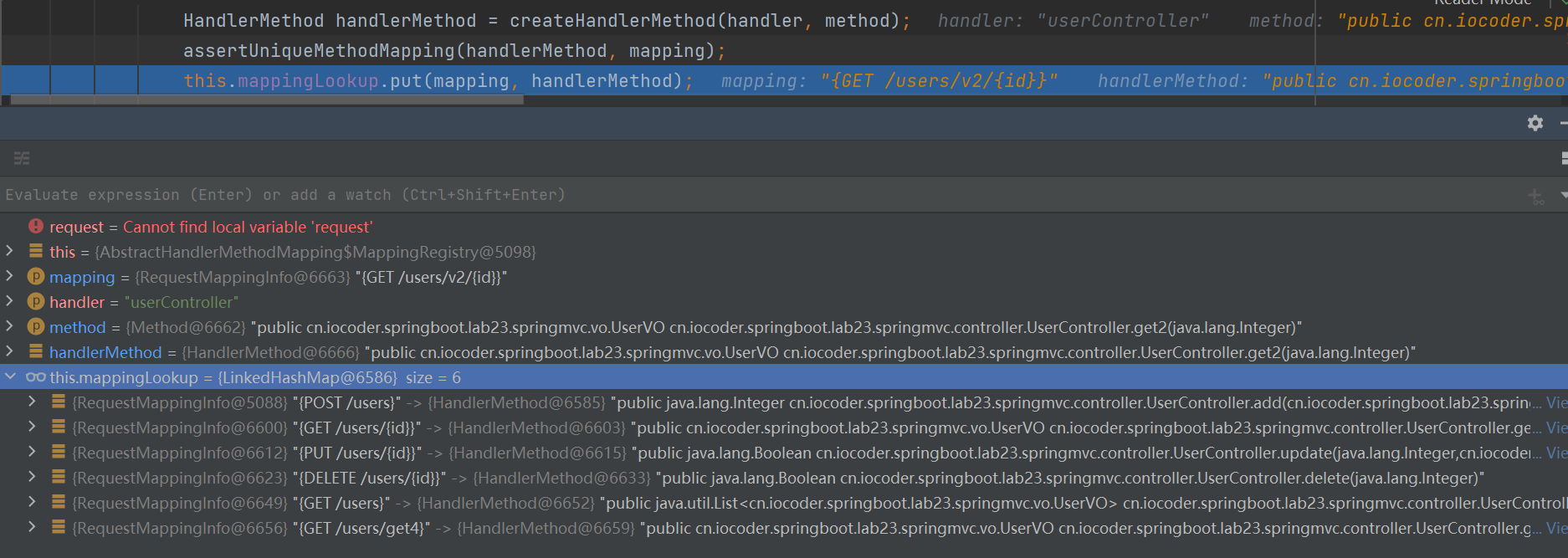
等后面有请求到来,就进入匹配的match方法。
public class RequestMappingHandlerMapping extends RequestMappingInfoHandlerMapping
implements MatchableHandlerMapping, EmbeddedValueResolverAware {
@Override
public RequestMatchResult match(HttpServletRequest request, String pattern) {
RequestMappingInfo info = RequestMappingInfo.paths(pattern).options(this.config).build();
RequestMappingInfo matchingInfo = info.getMatchingCondition(request);
if (matchingInfo == null) {
return null;
}
Set<String> patterns = matchingInfo.getPatternsCondition().getPatterns();
String lookupPath = getUrlPathHelper().getLookupPathForRequest(request);
return new RequestMatchResult(patterns.iterator().next(), lookupPath, getPathMatcher());
}
}获取Handler
我们现在都是使用@RequestMapping,@GetMapping,@PostMapping这种写法,那么它默认使用的HandlerMapping 类就是 RequestMappingHandlerMapping 类。

在这里我们可以看到Spring MVC在决定要使用哪个 HandlerMapping 的时候,它返回的 Handler是一个 HandlerExecutionChain 对象,它持有一个 handler ,这个handler 是一个 HandleMethod对象,仔细观察这个对象,发现它method属性就是一个方法Method,这个方法正好是这个请求"GET /users"对应的@GetMapping 注解修饰的Controller 类的方法。在寻找 HandlerMapping 结束的时候,Spring MVC已经知道了这个请求的对应处理方法是哪一个了。
public class HandlerExecutionChain {
private final Object handler;
@Nullable
private HandlerInterceptor[] interceptors;
@Nullable
private List<HandlerInterceptor> interceptorList;
private int interceptorIndex = -1;
}
@RestController
@RequestMapping("/users")
public class UserController {
@Autowired
private UserService userService;
@GetMapping("")
public List<UserVO> list() {
// 查询列表
...
return result;
}在AbstractHandlerMapping 类中,它调用
public final HandlerExecutionChain getHandler(HttpServletRequest request) throws Exception {
Object handler = getHandlerInternal(request);
if (handler == null) {
handler = getDefaultHandler();
}
if (handler == null) {
return null;
}
// Bean name or resolved handler?
if (handler instanceof String) {
String handlerName = (String) handler;
handler = obtainApplicationContext().getBean(handlerName);
}
HandlerExecutionChain executionChain = getHandlerExecutionChain(handler, request);
}
if (CorsUtils.isCorsRequest(request)) {
CorsConfiguration globalConfig = this.corsConfigurationSource.getCorsConfiguration(request);
CorsConfiguration handlerConfig = getCorsConfiguration(handler, request);
CorsConfiguration config = (globalConfig != null ? globalConfig.combine(handlerConfig) : handlerConfig);
executionChain = getCorsHandlerExecutionChain(request, executionChain, config);
}
return executionChain;
}然后程序调用AbstractHandlerMethodMapping 类的getHandlerInternal 方法。
public abstract class AbstractHandlerMethodMapping<T> extends AbstractHandlerMapping implements InitializingBean {
/**
* Look up a handler method for the given request.
*/
@Override
protected HandlerMethod getHandlerInternal(HttpServletRequest request) throws Exception {
String lookupPath = getUrlPathHelper().getLookupPathForRequest(request);
this.mappingRegistry.acquireReadLock();
try {
HandlerMethod handlerMethod = lookupHandlerMethod(lookupPath, request);
return (handlerMethod != null ? handlerMethod.createWithResolvedBean() : null);
}
finally {
this.mappingRegistry.releaseReadLock();
}
}
}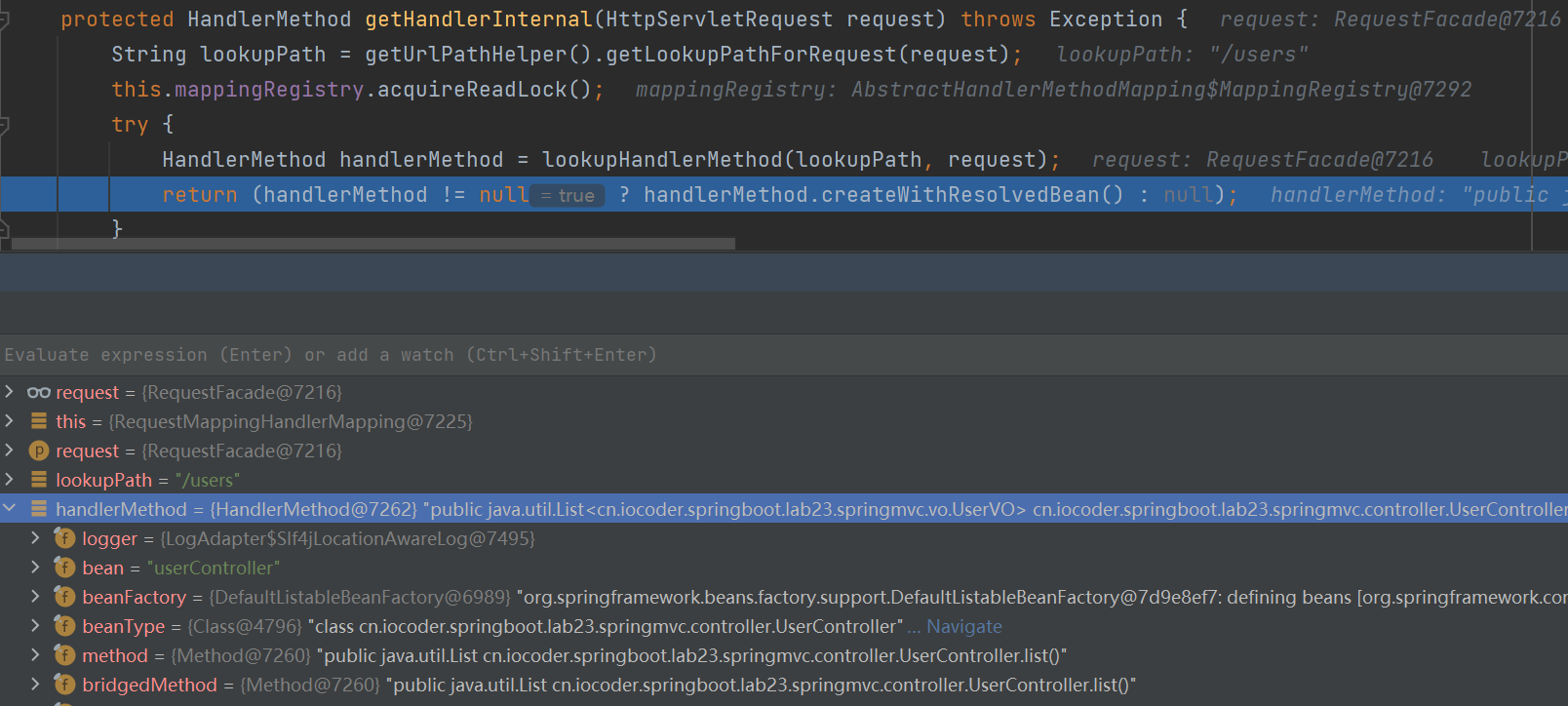
接着往下执行到
List<T> directPathMatches = this.mappingRegistry.getMappingsByUrl(lookupPath);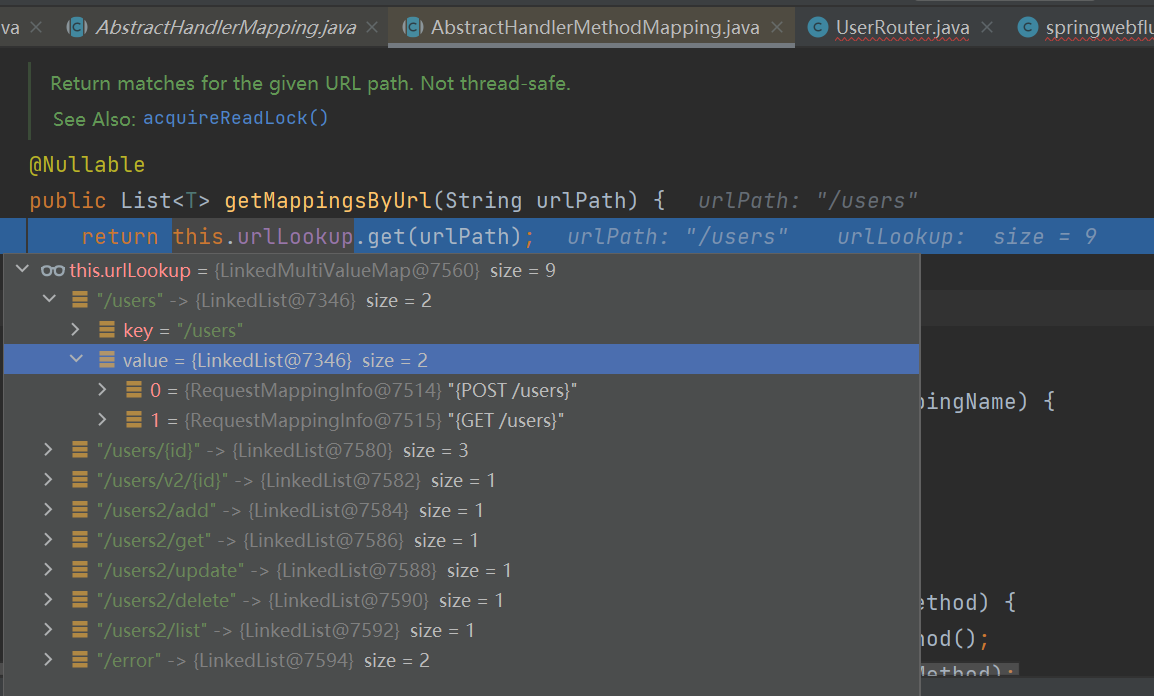
最终挑选到一个最符合的handlerMethod 返回。

在得到HandlerMethod的时候,它也会获取一下它的拦截器,由默认拦截器和我们自定义的拦截器构成,如果我们自定义一个登录拦截器,那么我们会使用一个url通配符 配置一下它的拦截范围,等到我们获取拦截器的时候会看一下当前的url是否要添加这个拦截器。
获取HandlerAdapter
得到HandlerExecutionChain 后,我们会获取适配器对象。
HandlerAdapter ha = getHandlerAdapter(mappedHandler.getHandler());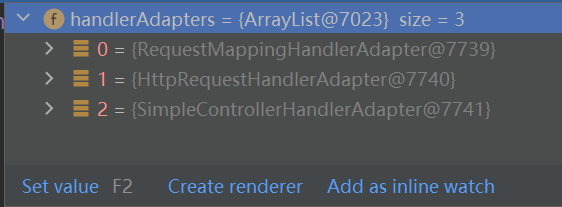
默认的适配器有3种,因为RequestMappingHandlerAdapter 支持HandlerMethod 类型,就交给它处理。
protected HandlerAdapter getHandlerAdapter(Object handler) throws ServletException {
if (this.handlerAdapters != null) {
for (HandlerAdapter adapter : this.handlerAdapters) {
if (adapter.supports(handler)) {
return adapter;
}
}
}
throw new ServletException("No adapter for handler [" + handler +
"]: The DispatcherServlet configuration needs to include a HandlerAdapter that supports this handler");
}在交给 HandlerAdapter 处理之前,它会先执行一下拦截器的prehandle 方法,如果返回false 就直接返回,不继续处理了。这是典型的责任链模式。
public class HandlerExecutionChain {
boolean applyPreHandle(HttpServletRequest request, HttpServletResponse response) throws Exception {
HandlerInterceptor[] interceptors = getInterceptors();
if (!ObjectUtils.isEmpty(interceptors)) {
for (int i = 0; i < interceptors.length; i++) {
HandlerInterceptor interceptor = interceptors[i];
if (!interceptor.preHandle(request, response, this.handler)) {
triggerAfterCompletion(request, response, null);
return false;
}
this.interceptorIndex = i;
}
}
return true;
}
}Spring MVC 也提供了异步的处理模式,但我们一般不会这样写,如果要写异步代码,直接使用Spring WebFlux。后面开始在HandlerAdapter 中处理了,它具体执行参数解析,反射调用Method,返回值格式处理。
然后一路调用到RequestMappingHandlerAdapter的invokeHandlerMethod方法中
public class RequestMappingHandlerAdapter extends AbstractHandlerMethodAdapter
implements BeanFactoryAware, InitializingBean {
protected ModelAndView invokeHandlerMethod(HttpServletRequest request,
HttpServletResponse response, HandlerMethod handlerMethod) throws Exception {
ServletWebRequest webRequest = new ServletWebRequest(request, response);
try {
WebDataBinderFactory binderFactory = getDataBinderFactory(handlerMethod);
ModelFactory modelFactory = getModelFactory(handlerMethod, binderFactory);
ServletInvocableHandlerMethod invocableMethod = createInvocableHandlerMethod(handlerMethod);
if (this.argumentResolvers != null) {
invocableMethod.setHandlerMethodArgumentResolvers(this.argumentResolvers);
}
if (this.returnValueHandlers != null) {
invocableMethod.setHandlerMethodReturnValueHandlers(this.returnValueHandlers);
}
invocableMethod.setDataBinderFactory(binderFactory);
invocableMethod.setParameterNameDiscoverer(this.parameterNameDiscoverer);
ModelAndViewContainer mavContainer = new ModelAndViewContainer();
mavContainer.addAllAttributes(RequestContextUtils.getInputFlashMap(request));
modelFactory.initModel(webRequest, mavContainer, invocableMethod);
mavContainer.setIgnoreDefaultModelOnRedirect(this.ignoreDefaultModelOnRedirect);
AsyncWebRequest asyncWebRequest = WebAsyncUtils.createAsyncWebRequest(request, response);
asyncWebRequest.setTimeout(this.asyncRequestTimeout);
WebAsyncManager asyncManager = WebAsyncUtils.getAsyncManager(request);
asyncManager.setTaskExecutor(this.taskExecutor);
asyncManager.setAsyncWebRequest(asyncWebRequest);
asyncManager.registerCallableInterceptors(this.callableInterceptors);
asyncManager.registerDeferredResultInterceptors(this.deferredResultInterceptors);
if (asyncManager.hasConcurrentResult()) {
Object result = asyncManager.getConcurrentResult();
mavContainer = (ModelAndViewContainer) asyncManager.getConcurrentResultContext()[0];
asyncManager.clearConcurrentResult();
LogFormatUtils.traceDebug(logger, traceOn -> {
String formatted = LogFormatUtils.formatValue(result, !traceOn);
return "Resume with async result [" + formatted + "]";
});
invocableMethod = invocableMethod.wrapConcurrentResult(result);
}
invocableMethod.invokeAndHandle(webRequest, mavContainer);
if (asyncManager.isConcurrentHandlingStarted()) {
return null;
}
return getModelAndView(mavContainer, modelFactory, webRequest);
}
finally {
webRequest.requestCompleted();
}
}
}WebDataBinderFactory 是处理WebDataBinder 的,它是处理 @InitBinder 注解的,类似于一个Request 范围的缓存,不过我们基本不使用它;ModelFactory和ModelAndViewContainer 是处理视图的,它会结合thymeleaf 等模板引擎进行使用,但是我们现在基本都是前后端分离的开发模式,所以它基本不会被用到,这些技术可以说是落后了,以后几乎不会遇到。这里的工作重心还是对HandlerMethod的处理,HandlerMethod 被包装为一个 ServletInvocableHandlerMethod 对象,然后设置参数解析类。
实际处理
public class ServletInvocableHandlerMethod extends InvocableHandlerMethod {
public void invokeAndHandle(ServletWebRequest webRequest, ModelAndViewContainer mavContainer,
Object... providedArgs) throws Exception {
Object returnValue = invokeForRequest(webRequest, mavContainer, providedArgs);
setResponseStatus(webRequest);
if (returnValue == null) {
if (isRequestNotModified(webRequest) || getResponseStatus() != null || mavContainer.isRequestHandled()) {
mavContainer.setRequestHandled(true);
return;
}
}
...
try {
this.returnValueHandlers.handleReturnValue(
returnValue, getReturnValueType(returnValue), mavContainer, webRequest);
}
...
}
public Object invokeForRequest(NativeWebRequest request, @Nullable ModelAndViewContainer mavContainer,
Object... providedArgs) throws Exception {
Object[] args = getMethodArgumentValues(request, mavContainer, providedArgs);
...
return doInvoke(args);
}
protected Object doInvoke(Object... args) throws Exception {
ReflectionUtils.makeAccessible(getBridgedMethod());
try {
return getBridgedMethod().invoke(getBean(), args);
}
catch (IllegalArgumentException ex) {
...
}
}
}上面的代码是核心代码,它会通过getMethodArgumentValues 方法解析出所有的参数信息,这里使用
protected Object[] getMethodArgumentValues(NativeWebRequest request, @Nullable ModelAndViewContainer mavContainer,
Object... providedArgs) throws Exception {
if (ObjectUtils.isEmpty(getMethodParameters())) {
return EMPTY_ARGS;
}
MethodParameter[] parameters = getMethodParameters();
Object[] args = new Object[parameters.length];
for (int i = 0; i < parameters.length; i++) {
MethodParameter parameter = parameters[i];
parameter.initParameterNameDiscovery(this.parameterNameDiscoverer);
args[i] = findProvidedArgument(parameter, providedArgs);
if (args[i] != null) {
continue;
}
if (!this.resolvers.supportsParameter(parameter)) {
throw new IllegalStateException(formatArgumentError(parameter, "No suitable resolver"));
}
try {
args[i] = this.resolvers.resolveArgument(parameter, mavContainer, request, this.dataBinderFactory);
}
catch (Exception ex) {
...
}
}
return args;
}。具体的解析细节也比较复杂,还可能会解析字节码。不同的传参方式对应的参数解析方式也不尽相同,比如Restful风格的参数解使用PathVariableMethodArgumentResolver。
如果是 @RequestParam 注解,就使用RequestParamMethodArgumentResolver去解析;
public class RequestParamMethodArgumentResolver extends AbstractNamedValueMethodArgumentResolver
implements UriComponentsContributor {
@Nullable
protected Object resolveName(String name, MethodParameter parameter, NativeWebRequest request) throws Exception {
HttpServletRequest servletRequest = request.getNativeRequest(HttpServletRequest.class);
if (servletRequest != null) {
Object mpArg = MultipartResolutionDelegate.resolveMultipartArgument(name, parameter, servletRequest);
if (mpArg != MultipartResolutionDelegate.UNRESOLVABLE) {
return mpArg;
}
}
Object arg = null;
MultipartRequest multipartRequest = request.getNativeRequest(MultipartRequest.class);
if (multipartRequest != null) {
List<MultipartFile> files = multipartRequest.getFiles(name);
if (!files.isEmpty()) {
arg = (files.size() == 1 ? files.get(0) : files);
}
}
if (arg == null) {
String[] paramValues = request.getParameterValues(name);
if (paramValues != null) {
arg = (paramValues.length == 1 ? paramValues[0] : paramValues);
}
}
return arg;
}
}如果使用了@RequestBody注解,前端使用json格式传递参数,后端使用 RequestResponseBodyMethodProcessor 类解析参数。
public class RequestResponseBodyMethodProcessor extends AbstractMessageConverterMethodProcessor {
public Object resolveArgument(MethodParameter parameter, @Nullable ModelAndViewContainer mavContainer,
NativeWebRequest webRequest, @Nullable WebDataBinderFactory binderFactory) throws Exception {
parameter = parameter.nestedIfOptional();
Object arg = readWithMessageConverters(webRequest, parameter, parameter.getNestedGenericParameterType());
String name = Conventions.getVariableNameForParameter(parameter);
if (binderFactory != null) {
WebDataBinder binder = binderFactory.createBinder(webRequest, arg, name);
if (arg != null) {
validateIfApplicable(binder, parameter);
if (binder.getBindingResult().hasErrors() && isBindExceptionRequired(binder, parameter)) {
throw new MethodArgumentNotValidException(parameter, binder.getBindingResult());
}
}
if (mavContainer != null) {
mavContainer.addAttribute(BindingResult.MODEL_KEY_PREFIX + name, binder.getBindingResult());
}
}
return adaptArgumentIfNecessary(arg, parameter);
}
}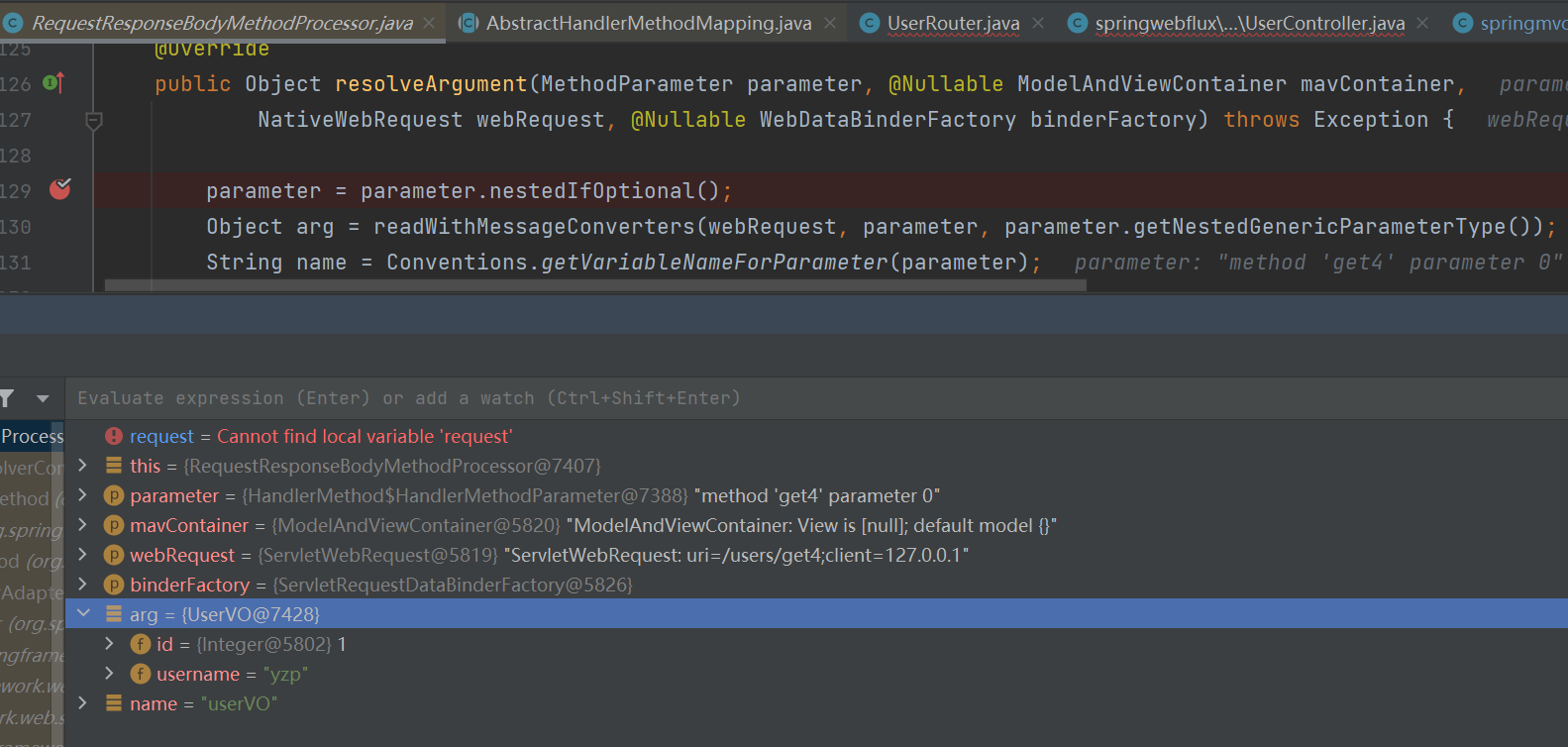
当然,把 json 反序列化为对象这个过程,使用到了AbstractJackson2HttpMessageConverter ,它继承了HttpMessageConverter 抽象类。
public abstract class AbstractJackson2HttpMessageConverter extends AbstractGenericHttpMessageConverter<Object> {
@Override
public Object read(Type type, @Nullable Class<?> contextClass, HttpInputMessage inputMessage)
throws IOException, HttpMessageNotReadableException {
JavaType javaType = getJavaType(type, contextClass);
return readJavaType(javaType, inputMessage);
}
private Object readJavaType(JavaType javaType, HttpInputMessage inputMessage) throws IOException {
try {
if (inputMessage instanceof MappingJacksonInputMessage) {
Class<?> deserializationView = ((MappingJacksonInputMessage) inputMessage).getDeserializationView();
if (deserializationView != null) {
return this.objectMapper.readerWithView(deserializationView).forType(javaType).
readValue(inputMessage.getBody());
}
}
return this.objectMapper.readValue(inputMessage.getBody(), javaType);
}
catch (InvalidDefinitionException ex) {
throw new HttpMessageConversionException("Type definition error: " + ex.getType(), ex);
}
catch (JsonProcessingException ex) {
throw new HttpMessageNotReadableException("JSON parse error: " + ex.getOriginalMessage(), ex, inputMessage);
}
}
}
基本上我们后端传参的方式也就 @PathVariable,@RequestParam,@ResponseBody这几种,Spring MVC都有对应的参数解析器来解析它们。
然后反射调用Method,得到返回值,然后使用returnValueHandlers 处理一下返回值,就返回了。
处理返回
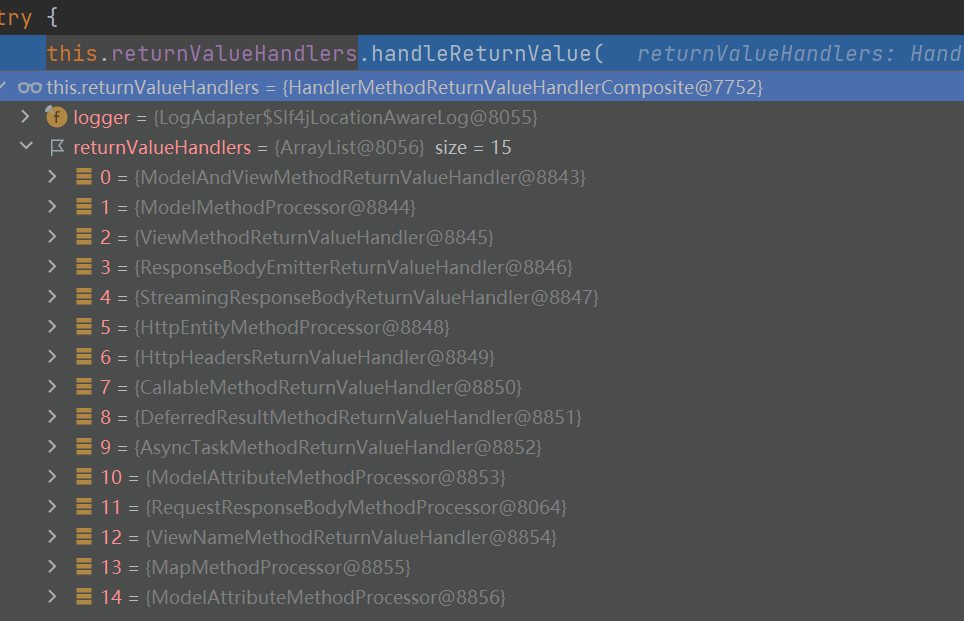
在这里,它使用RequestResponseBodyMethodProcessor 处理返回值,解析一下前端可以接收的MediaType,把Method执行结果写入到响应流里面去。
public class RequestResponseBodyMethodProcessor extends AbstractMessageConverterMethodProcessor {
public void handleReturnValue(@Nullable Object returnValue, MethodParameter returnType,
ModelAndViewContainer mavContainer, NativeWebRequest webRequest)
throws IOException, HttpMediaTypeNotAcceptableException, HttpMessageNotWritableException {
mavContainer.setRequestHandled(true);
ServletServerHttpRequest inputMessage = createInputMessage(webRequest);
ServletServerHttpResponse outputMessage = createOutputMessage(webRequest);
// Try even with null return value. ResponseBodyAdvice could get involved.
writeWithMessageConverters(returnValue, returnType, inputMessage, outputMessage);
}
}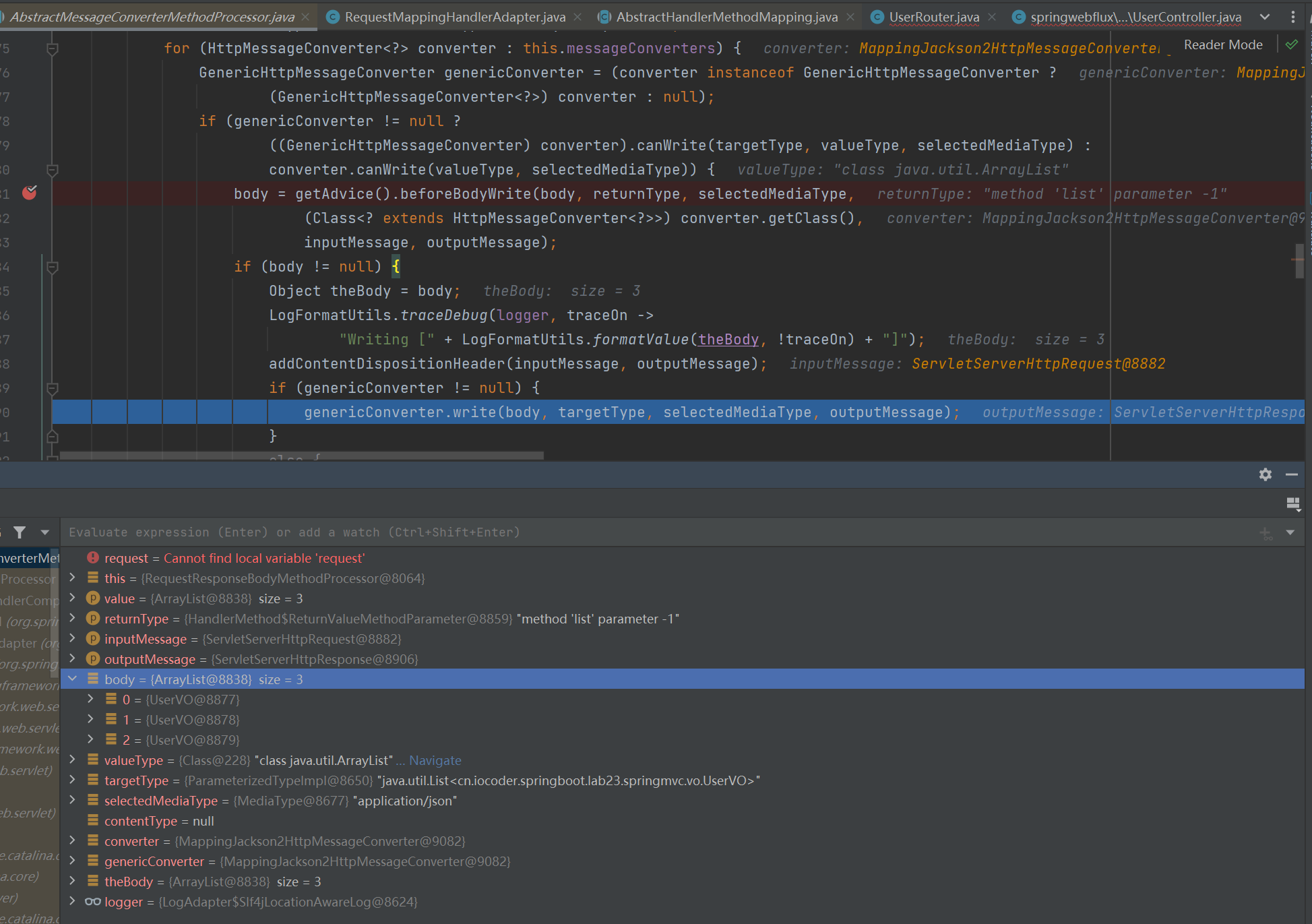
巧了,实际把返回值写入到响应流的类也是 AbstractJackson2HttpMessageConverter ,之前处理@RequestBody 把 json 转为对象的也是它。
public abstract class AbstractJackson2HttpMessageConverter extends AbstractGenericHttpMessageConverter<Object> {
@Override
protected void writeInternal(Object object, @Nullable Type type, HttpOutputMessage outputMessage)
throws IOException, HttpMessageNotWritableException {
MediaType contentType = outputMessage.getHeaders().getContentType();
JsonEncoding encoding = getJsonEncoding(contentType);
JsonGenerator generator = this.objectMapper.getFactory().createGenerator(outputMessage.getBody(), encoding);
try {
writePrefix(generator, object);
Object value = object;
Class<?> serializationView = null;
FilterProvider filters = null;
JavaType javaType = null;
if (object instanceof MappingJacksonValue) {
MappingJacksonValue container = (MappingJacksonValue) object;
value = container.getValue();
serializationView = container.getSerializationView();
filters = container.getFilters();
}
if (type != null && TypeUtils.isAssignable(type, value.getClass())) {
javaType = getJavaType(type, null);
}
ObjectWriter objectWriter = (serializationView != null ?
this.objectMapper.writerWithView(serializationView) : this.objectMapper.writer());
if (filters != null) {
objectWriter = objectWriter.with(filters);
}
if (javaType != null && javaType.isContainerType()) {
objectWriter = objectWriter.forType(javaType);
}
SerializationConfig config = objectWriter.getConfig();
if (contentType != null && contentType.isCompatibleWith(MediaType.TEXT_EVENT_STREAM) &&
config.isEnabled(SerializationFeature.INDENT_OUTPUT)) {
objectWriter = objectWriter.with(this.ssePrettyPrinter);
}
objectWriter.writeValue(generator, value);
writeSuffix(generator, object);
generator.flush();
}
catch (InvalidDefinitionException ex) {
throw new HttpMessageConversionException("Type definition error: " + ex.getType(), ex);
}
catch (JsonProcessingException ex) {
throw new HttpMessageNotWritableException("Could not write JSON: " + ex.getOriginalMessage(), ex);
}
}
}继续往后执行,它会获取视图名称,但是返回空。
return getModelAndView(mavContainer, modelFactory, webRequest);回到DispatchServlet,它会把拦截器的后置处理postHandle,afterCompletion等方法也执行一遍,这样一个请求就结束处理了。
总结一下
在Spring MVC 容器启动的时候,它会扫描有@Controller的类,并把它的有@RequestMapping 注释的方法解析出来,当有一个请求到来时,它会匹配到对于的HandlerMethod,然后处理入参,执行该方法,把结果写入到响应流中去。Open Feign,Gateway也有类似的处理流程。





















 625
625











 被折叠的 条评论
为什么被折叠?
被折叠的 条评论
为什么被折叠?








